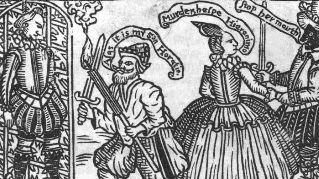Computer Software Proves Shakespeare Co-Authored Plays

What’s the Big Idea?
When CBS’s crime scene drama CSI became the most-watched show on TV in 2002, many other networks developed a crime scene drama of their own. This isn’t much different from what happened in Elizabethan times, as certain genres such as histories or bloody revenge tragedies suddenly came into vogue, often based on the success of a particular stage production. One such trend-setting production was Thomas Kyd’s The Spanish Tragedy(1587), a play that has long been noted for its influence on William Shakespeare’s Hamlet. What hasn’t been realized until recent times is the possibility that Shakespeare revised the play for a revival in 1599.
Sir Brian Vickers, a literary scholar and author of Shakespeare, Co-Author is out to change all of that. Sir Brian has applied the scientific method to attribution studies on Shakespeare, a field he says is too often driven by an “awful snobbery,” the prejudice that because he came from a tradesman’s family and only attended grammar school, not university, he was incapable of writing plays. Sir Brian has also caused quite a stir among another opposing camp–those who wish to cling to the Romantic view that Shakespeare worked entirely as a solitary genius. Sir Brian argued persuasively in his 2002 book that five plays in the Shakespeare canon are collaborations. In 2008, Sir Brian found Shakespeare’s linguistic fingerprint in four scenes of The Reign of King Edward III, a play whose authorship has been disputed since it was printed anonymously in 1596.
In a recent interview with Big Think, Sir Brian explained his pioneering use of corpus linguistics and computer software to prove Shakespeare’s co-authorship of additional scenes in The Spanish Tragedy.
What’s the Breakthrough?
Sir Brian has employed software called Pl@giarism–a free program developed by Maastricht University to catch law students cheating on their written work–to search a database of the 58 different plays performed in London between 1580 and 1595. But Sir Brian isn’t looking to catch anyone cheating. Rather, he is looking for examples of so-called “self-plagiarism.” The Pl@giarism software identifies every occasion that a sequence of three words appears in Shakespeare’s known works, and then looks for repetitions of these sequences in an unattributed text. Some of these word sequences are common, everyday collocations such as “by the way” or “Yes, my lord.”
Excluding those phrases, Sir Brian focuses on word sequences that are unique to Shakespeare. For instance, the word sequence “eyebrows jutty over” appears only twice in all of Elizabethan drama. One instance is in Shakespeare’s Henry V, written in approximately 1599. The only other instance is found in the fourth edition of Thomas Kyd’s “The Spanish Tragedy,” published in 1602. This version contains additions to five scenes, totaling 320 lines. In these short passages, Sir Brian found 46 collocation matches that are completely unique to Shakespeare’s poems and plays written before 1596. That evidence is hard to argue with.
Yet some may ask why Shakespeare, the author of the greatest plays in the English language, would tinker with the works of a lesser playwright from a rival company. Given the success of The Spanish Tragedy in Elizabethan times, this should be no surprise at all. As Sir Brian notes, Shakespeare’s theater company at the time–Lord Chamberlain’s Men–was free to produce the play, and there is strong evidence that they likely did.* As Sir Brian explains, “it costs a lot less for a Broadway company to revise South Pacificand add a few show tunes than to commission a new musical.” The same was true for the four competing theater companies in London who operated during the height of the Elizabethan theater boom. As the premier dramatist for Lord Chamberlain’s Men, Shakespeare–like every other dramatist working at the time–was a collaborator.
Lesson plan:
Still not convinced? Sir Brian offers an “experiment” for you. Follow this link to the text of Edward III and read the first scene. After doing so, according to Sir Brian, you will most likely “feel that you’re in for a long haul.” (It’s quite boring.) Then read the next three scenes, which are brilliant. Sir Brian says that’s because Shakespeare wrote those three scenes, and another dramatist wrote the first one. Go ahead, see for yourself.
*The most convincing evidence links Richard Burbage, the leading actor in Lord Chamberlain’s Men, to performances where he played Jeronimo, one of the principal characters in The Spanish Tragedy.
Follow Daniel Honan on Twitter @DanielHonan




